The other day, I was having a conversation with a friend about a brand new corduroy shirt from Banana Republic I found at Goodwill. She told me about a similar item she found at Plato’s Closet, and we proceeded to have a lively conversation about how much we both love thrifting.
And it’s true — for the most part, I prefer thrifting my clothes to buying them new.
I have a couple of reasons for this. The first is that it’s simply cheaper and, being a broke college student, I need to save as much money as possible. The second is that, as is well known at this point, fast fashion is far less than ethical, and thrifting is an easy way to support, say, a nonprofit organization like Goodwill rather than a multibillion dollar corporation like H&M.
It’s primarily for this latter reason that thrifting has grown in popularity among young people, specifically young people who are both politically aware and concerned with fashion. And it’s hard to argue that this is inherently a bad thing — thrifting is more ethical, after all, and any money given to a thrift store rather than a fast fashion brand is money well spent.
But this becomes a problem when the thrifting demographic becomes largely composed of more affluent consumers who are simply following a trend. Thrifting used to carry with it negative connotations: if you thrifted, you must’ve been poor and dirty. Today, if you thrift, you’re politically and environmentally conscious and looking good on top of it.
This line of thinking, however, ignores the history of thrifting and its creation as a convenient, cheap way for the working class to acquire clothes. When Goodwill was founded in 1902, it almost exclusively hired poor people and people with disabilities, and it targeted its business specifically at immigrants living in Boston. The Salvation Army thrift store had similar roots about five years prior.
So, when the trendy, wealthier consumers I described shop at thrift stores en masse and overconsume, it limits the options available for those who don’t have any others. It becomes an even more pertinent issue when you think of sites like Depop or the recent trend of reselling vintage clothing — it’s almost impossible to go to any local art or music festival and not see at least a few vendors reselling thrifted items.
With this, the trend of thrifting — read, overconsumption — in the name of environmental and economic sustainability becomes something closer to gentrification.
[Related: OPINION: Low-rise jeans means a high rise of "skinny"]
To put it succinctly, gentrification is the process by which disinvested neighborhoods undergo rapid change due to an increase of wealthier residents moving in and establishing high-end businesses, therefore displacing the poor people who initially resided there. In this case, it means purchasing a large amount of products from Goodwill; reselling them online for much, much more than you purchased them for; inadvertently raising the prices of thrifted goods in stores; and preventing the people who need them most from accessing them.
Clothes are important. We don’t like to think appearances matter, but they do — the majority of employers, for example, say a candidate’s dress sense affects their hiring decision. Whether or not this is morally correct doesn’t matter: it’s the reality of the world we currently live in. And, if you’re poor and can’t afford to shell out the money for a brand new suit, you’re going to check the racks at your local thrift stores. Because, in this scenario, no suit could mean no job.
On top of the trend of reselling vintage clothing is the trend of upcycling or otherwise modifying clothing, a practice that often relies on larger-sized items so one can refashion them to fit a thinner frame. There’s a clear link between poverty and obesity. Poor people are much more likely to buy plus-size clothing compared to wealthier shoppers, but the ever-increasing gentrification of the thrifting industry has made finding these items much more difficult.
None of this is to say that thrifting is bad or that we should thrift less often. It’s wonderful that younger people and people of higher income brackets want to buy used clothing. Thrift stores, vintage vendors and Depop play a significant role in cutting out the environmental and social degradation that comes with supporting corporate fashion. In short, we should be upcycling our clothing, donating our unwanted items and buying secondhand — to do so is to be sustainable.
[Related: OPINION: Self-care should have nothing to do with consumption]
But, to be truly sustainable is to support those who are less fortunate and are most negatively affected by our capitalist economy. And in that sense, there is nothing sustainable about the gentrification of thrifting, no matter how ethical the practice itself is. A truly ethical practice must include the ones who have the most to lose.
Joey Sills (he/him) is a junior studying journalism, political science and film production.






